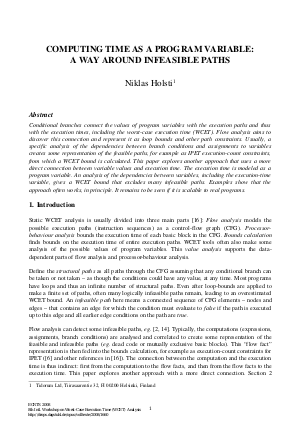Computing time as a program variable: a way around infeasible paths
Author Niklas Holsti
-
Part of:
Volume:
8th International Workshop on Worst-Case Execution Time Analysis (WCET'08) (WCET 2008)
Part of: Series: Open Access Series in Informatics (OASIcs)
Part of: Conference: Workshop on Worst-Case Execution Time Analysis (WCET) - License:
 Creative Commons Attribution-NonCommercial-NoDerivs 3.0 Unported license
Creative Commons Attribution-NonCommercial-NoDerivs 3.0 Unported license
- Publication Date: 2008-11-13
File

PDF
OASIcs.WCET.2008.1660.pdf
- Filesize: 0.62 MB
- 11 pages
Document Identifiers
Subject Classification
Keywords
- WCET
- flow analysis
- infeasible paths
- dependency analysis
Metrics
- Access Statistics
-
Total Accesses (updated on a weekly basis)
0Document
0Metadata
Abstract
Conditional branches connect the values of program variables with the execution paths and thus with the execution times, including the worst-case execution time (WCET). Flow analysis aims to discover this connection and represent it as loop bounds and other path constraints. Usually, a specific analysis of the dependencies between branch conditions and assignments to variables creates some representation of the feasible paths, for example as IPET execution-count constraints, from which a WCET bound is calculated. This paper explores another approach that uses a more direct connection between variable values and execution time. The execution time is modeled as a program variable. An analysis of the dependencies between variables, including the execution-time variable, gives a WCET bound that excludes many infeasible paths. Examples show that the approach often works, in principle. It remains to be seen if it is scalable to real programs.
Cite As Get BibTex
Niklas Holsti. Computing time as a program variable: a way around infeasible paths. In 8th International Workshop on Worst-Case Execution Time Analysis (WCET'08). Open Access Series in Informatics (OASIcs), Volume 8, pp. 1-11, Schloss Dagstuhl – Leibniz-Zentrum für Informatik (2008)
https://doi.org/10.4230/OASIcs.WCET.2008.1660
BibTex
@InProceedings{holsti:OASIcs.WCET.2008.1660,
author = {Holsti, Niklas},
title = {{Computing time as a program variable: a way around infeasible paths}},
booktitle = {8th International Workshop on Worst-Case Execution Time Analysis (WCET'08)},
pages = {1--11},
series = {Open Access Series in Informatics (OASIcs)},
ISBN = {978-3-939897-10-1},
ISSN = {2190-6807},
year = {2008},
volume = {8},
editor = {Kirner, Raimund},
publisher = {Schloss Dagstuhl -- Leibniz-Zentrum f{\"u}r Informatik},
address = {Dagstuhl, Germany},
URL = {https://drops.dagstuhl.de/entities/document/10.4230/OASIcs.WCET.2008.1660},
URN = {urn:nbn:de:0030-drops-16608},
doi = {10.4230/OASIcs.WCET.2008.1660},
annote = {Keywords: WCET, flow analysis, infeasible paths, dependency analysis}
}
